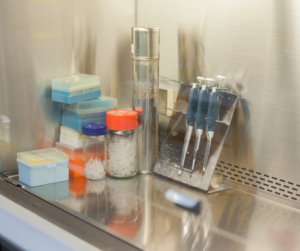Ductless fume hoods have become a practical solution for laboratories that want strong chemical protection without installing costly ductwork. These hoods use specialized filtration technology to capture hazardous vapors, returning clean air back into the room. Understanding how they operate and when they are appropriate is essential for maintaining a safe, compliant workspace.
This guide explains what a ductless fume hood is, how it works, where it fits best, and what to consider when selecting the right model for your lab.
What is a Ductless Fume Hood?
A ductless fume hood, also called a filtered fume hood or recirculating fume hood, is a self-contained safety enclosure designed to remove chemical fumes and particulates at the work surface. Instead of exhausting contaminated air through building ductwork, a ductless system pulls air through a series of filters and returns cleaned air back into the laboratory.
Key characteristics
- No external ductwork required — ideal for spaces without existing ventilation infrastructure.
- Lightweight and mobile — easy to relocate or reconfigure as laboratory needs change.
- Filtration-based containment — typically uses activated carbon, HEPA, or combination filters depending on chemical type.
- Lower installation costs — no mechanical exhaust or structural modifications.
Because they operate independently of the facility’s HVAC, ductless units offer flexibility that traditional ducted hoods cannot.
How Does a Ductless Fume Hood Work?
A ductless fume hood uses a controlled airflow path and targeted filtration to capture harmful vapors at the source. The basic sequence includes:
1. Air Intake and Contaminant Capture
The hood’s blower draws room air through the sash opening, pulling vapors and aerosols away from the user. Contaminants are immediately directed toward the filtration chamber.
2. Pre-Filter Stage
A pre-filter removes dust and large particulates that could interfere with the efficiency of the main filter. This step protects the filtration media and helps maintain consistent airflow.
3. Primary Filtration
The main filter is selected based on chemical compatibility:
- Activated carbon filters: Adsorb organic vapors, solvents, and many volatile chemicals.
- Specialty carbon blends: Designed for acids, ammonia, formaldehyde, or mixed chemical use.
- HEPA filters: Capture biological particles or fine particulates for hybrid chemical/particulate applications.
As air moves through the filter bed, chemical molecules adhere to the media. The efficiency of this process depends on chemical concentration, filter design, and proper selection for the chemicals used.
4. Clean Air Recirculation
After passing through the filter, treated air is recirculated safely back into the laboratory. Because airflow remains contained within the unit, ductless hoods avoid the energy loss associated with exhausting conditioned air outdoors.
When Does a Ductless Fume Hood Make Sense?
Ductless fume hoods are effective for many applications, but they are not suited to every environment. Selecting the right hood requires understanding your chemical usage, workflow, and safety requirements.
Appropriate use cases
A ductless hood is often a good fit for:
- Teaching labs, R&D spaces, and small-scale experiments
- Work involving low-to-moderate volumes of compatible chemicals
- Facilities where the installation of ductwork is impractical or cost-prohibitive
- Labs that need flexible, mobile containment solutions
- Users handling a narrow, predictable chemical set
Limitations and considerations
Every filtration-based hood has constraints:
- Noise from the fan
- Filter replacement requirements
- Ongoing monitoring for filter saturation
- Restricted chemical compatibility
- Not appropriate for high volumes or highly toxic compounds
A ductless hood protects effectively when filters are correctly specified and replaced on schedule. If your workflows involve a wide range of chemicals, high evaporation rates, or unknown mixtures, a ducted system may be safer.
Questions to Ask Before Choosing a Ductless System
To make an informed decision, evaluate the following:
Chemical Compatibility
- What chemicals will be used, and in what concentrations?
- Are these chemicals approved for carbon or specialty filtration?
- Will the lab handle mixtures that could overwhelm filters?
Volume and Frequency
- Are procedures occasional or continuous?
- What is the expected evaporation rate?
Compliance and Safety Requirements
- Does your EHS department permit ductless systems for your use case?
- Are there institutional standards or certifications required?
Cost of Ownership
- How frequently will filters need to be replaced?
- What are the long-term operating costs compared to a ducted system?
Answering these questions narrows down which model and which filter configuration offers the safest, most efficient protection for your space.
Selecting the correct hood isn’t just about airflow; it’s about matching filtration technology to real-world lab conditions. Our team can help evaluate your chemical usage, compare filtered versus ducted options, and recommend the configuration that best supports your safety goals. Contact us today!



